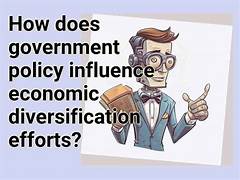Government Policies and Economic Development: A Comparative Analysis
Government policies play a pivotal role in shaping the economic trajectory of a nation. The decisions made by policymakers in areas such as taxation, education, infrastructure, trade, and labor laws have profound effects on a country’s economic growth and development. In this article, we will explore the ways in which government policies influence economic development, compare the policies of different nations, and examine the impact of these policies on both emerging and developed economies.
The Role of Government Policies in Economic Development
At its core, economic development refers to the process by which a nation improves the standard of living, economic health, and overall prosperity of its people. Governments are central to this process because they create the environment in which businesses operate, individuals work, and resources are allocated. The policies governments put in place can either stimulate growth and prosperity or create barriers that slow down development.
The impact of government policies on economic development is multifaceted. Here are some of the main ways in which policies influence a nation’s economy:
- Fiscal and Monetary Policy: Fiscal policies, which involve government spending and taxation, are critical tools for managing the economy. Through tax cuts, government investments, or social spending, governments can stimulate economic activity, boost consumer confidence, and reduce unemployment. Conversely, raising taxes or reducing public spending can cool an overheated economy. Monetary policies, managed by central banks, control the money supply and interest rates. By adjusting interest rates, central banks can encourage borrowing and investment or curb inflation. A sound monetary policy helps stabilize the economy and prevent excessive booms and busts.
- Education and Human Capital Development: Investing in education and human capital is crucial for long-term economic development. Governments that prioritize access to quality education, technical training, and workforce development create a skilled labor force capable of driving innovation and productivity. Countries that have strong educational policies, such as Finland, are often able to reap the benefits of a highly educated workforce, which contributes to higher levels of economic output.
- Infrastructure Development: Governments also play a key role in the development of infrastructure, which includes transportation, energy, telecommunications, and healthcare systems. Adequate infrastructure facilitates business operations, reduces transaction costs, and improves living standards. Effective transportation networks can improve supply chain efficiency, while access to reliable energy sources is essential for industries and households alike.
- Trade and Foreign Policy: Government trade policies have direct implications for the openness of an economy. Free trade agreements, tariffs, and import-export regulations determine how a country interacts with the global market. Governments can stimulate economic growth by promoting exports and attracting foreign direct investment (FDI). Countries with open economies, such as Singapore, often experience greater economic development due to their integration into global trade networks.
- Regulation and Business Environment: The ease of doing business within a country is heavily influenced by government regulations. Policies related to labor laws, property rights, business taxes, and anti-corruption measures create the environment in which businesses thrive. A supportive regulatory environment can encourage entrepreneurship, foster innovation, and attract both domestic and foreign investment.
Comparing Government Policies Across Economies
Government policies are not uniform across the globe. Different nations, depending on their economic contexts, historical backgrounds, and political structures, implement varying strategies to foster economic development. Let’s examine the policies of a few countries to better understand their approach to economic growth.
Developed Economies: The United States and Germany
- United States: The United States has long embraced a market-driven approach to economic development, relying on minimal government interference in business activities. However, the government plays a crucial role in areas such as defense, infrastructure, and education. The U.S. has a relatively low tax burden compared to other developed nations, which encourages entrepreneurship and attracts investment. Additionally, the country has fostered innovation through research and development (R&D) incentives, particularly in sectors like technology, healthcare, and defense. The U.S. also focuses on attracting foreign investment by maintaining a business-friendly environment. For instance, the U.S. tax system encourages companies to reinvest profits domestically rather than sending them abroad. The government has also implemented fiscal stimulus packages during periods of economic downturns, such as the 2008 financial crisis and the COVID-19 pandemic, to stimulate demand and support businesses and individuals. Despite these strengths, the U.S. faces challenges related to income inequality, healthcare accessibility, and a growing national debt. These issues sometimes complicate efforts to achieve equitable economic growth.
- Germany: Germany’s economic policies emphasize stability, social welfare, and industrial growth. The government’s “social market economy” model combines free-market capitalism with a strong welfare state. The country has a well-developed social safety net, including universal healthcare and a robust unemployment insurance system. Education, particularly vocational training, is central to Germany’s success, providing a skilled workforce that fuels the industrial sector. Germany’s economic policies are also designed to promote exports and technological innovation. The government supports industries such as automotive manufacturing, machinery, and chemicals through subsidies and tax incentives for R&D. Additionally, Germany has a strong emphasis on environmental sustainability and energy transition, which is reflected in policies like the “Energiewende,” a move towards renewable energy sources. Germany’s social market economy ensures that economic development benefits a broad swath of society, with an emphasis on social welfare and job security. However, challenges such as an aging population and an over-reliance on exports have led to some concerns about future growth.
Emerging Economies: China and India
- China: China’s approach to economic development has been one of state-driven capitalism, with a strong central government playing an active role in the economy. Since the 1980s, China has adopted a mix of market reforms alongside state control over strategic sectors such as energy, telecommunications, and banking. The government has invested heavily in infrastructure, industrialization, and technological innovation, positioning China as a global economic powerhouse. Policies such as export-led growth, foreign direct investment attraction, and the development of Special Economic Zones (SEZs) have been central to China’s rapid economic expansion. The government also plays a key role in education and healthcare, although these systems face challenges related to inequality, especially between urban and rural areas. However, China faces challenges related to income inequality, environmental degradation, and an aging population. The government is now shifting its focus to domestic consumption and high-tech industries to sustain long-term growth.
- India: India’s economic policies have evolved over time, with a mix of state-led industrialization in the post-independence era followed by liberalization in the 1990s. The government’s focus has been on promoting sectors like information technology, services, and agriculture. India has emphasized policies to attract foreign investment, particularly in the technology sector, and has worked to reduce barriers to trade. One of India’s significant challenges is the vast disparity between urban and rural areas, with unemployment rates and poverty levels remaining high in rural regions. The government has initiated programs such as “Make in India” to encourage domestic manufacturing and job creation. There have also been efforts to improve infrastructure, such as expanding digital connectivity, which could be a key driver for future economic growth. Despite these efforts, India struggles with regulatory inefficiencies, corruption, and a lack of adequate labor market reforms, which hinder full economic development. India’s future growth will depend on how effectively it can address these systemic issues.
Conclusion
Government policies are instrumental in shaping a nation’s economic development. The decisions governments make regarding taxation, trade, infrastructure, education, and social welfare directly influence economic outcomes. The comparative analysis of policies in countries like the United States, Germany, China, and India reveals that while there is no one-size-fits-all approach to development, certain common elements such as investment in human capital, infrastructure, and innovation tend to drive economic progress.
For emerging economies, the challenge is often to strike a balance between market reforms and government intervention. In developed economies, the focus tends to be on maintaining stability, addressing social inequality, and adapting to global economic changes. Ultimately, effective government policies are those that support inclusive growth, encourage innovation, and create an environment conducive to long-term prosperity.


